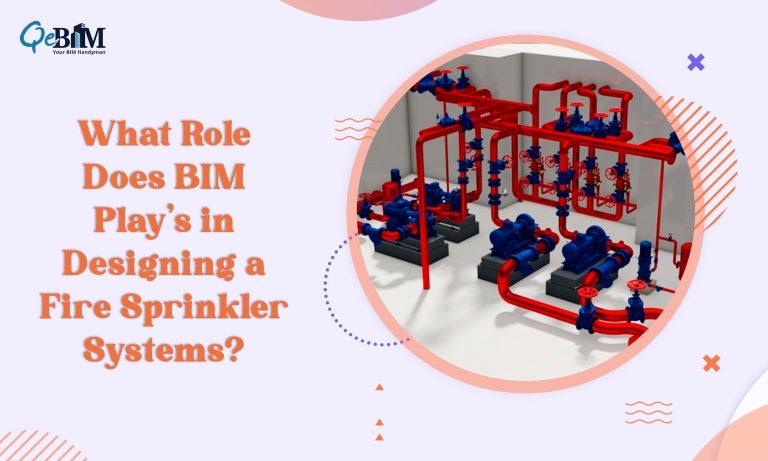What Role Does BIM Play’s in Designing a Fire Sprinkler Systems?

While designing any building or infrastructure, the accurate drawings of MEPF components (Mechanical, Electrical, Plumbing and Fire) play a crucial role. The coordination among them is quite important to avoid potential disasters and for this reason opting out for the best MEPF BIM Services is a must.
Among MEPF components, fire sprinkler systems stand as one of the most crucial defences against potential hazards. These systems are designed to detect and extinguish fires automatically, thereby safeguarding lives and minimizing property damage. Designing an efficient Fire sprinkler system is quite tedious and complex task. Integrating BIM in their design and implementation is essential for comprehending their effectiveness and efficiency. Let’s take a look at how. But first let’s peek in to what actually is a Fire Sprinkler System and its key elements.
What is a Fire Sprinkler System?
A fire sprinkler system is a network of pipes, valves, and sprinkler heads installed within a building to detect and control fires. Contrary to popular belief, not all sprinklers activate at once; rather, they are individually triggered by the heat, typically when the temperatures reaches at the high levels which indicates of a fire. This targeted response ensures that water is directed only where needed, minimizing water damage to unaffected areas of the building.
Key Elements of a Fire Sprinkler System:
- Sprinkler Heads: These are the most visible components of the system which are usually mounted on the ceilings. Each sprinkler head is equipped with a glass bulb or a fusible link that bursts or melts at a specific temperature thereby allowing water to flow onto the fire below.
- Piping: The network of pipes distributes water from a reliable water source (such as a dedicated water tank or the municipal water supply) to the sprinkler heads throughout the building.
- Valves: Valves are known to control the flow of water within the system. They can be activated manually or automatically depending on the system’s design as well as requirements.
- Alarm Initiating Devices: These devices do detect fire or smoke and are known to trigger the activation of the sprinkler system. They can include smoke detectors, heat detectors, or manual alarm stations.
- Pump and Water Supply: In some cases, a pump is necessary to ensure the adequate water pressure within the sprinkler system especially in the high-rise buildings or areas with low water pressure.
- Monitoring and Control Panel: This panel monitors the system’s status, alerts building occupants in case of a fire as well as provides control over the system’s operation.
The Role of BIM in Fire Sprinkler Systems:
BIM has revolutionized the design, construction, and maintenance of building systems, including fire sprinkler systems. It showcases the physical as well as operational characteristics of a building, integrating architecture, engineering, and construction data into a single 3D model. Here’s how BIM enhances the effectiveness of fire sprinkler systems:
- Enhanced Design Accuracy: BIM allows fire protection engineers to create detailed, accurate 3D models of fire sprinkler systems. These models simulate how the system will perform under various scenarios, optimizing design decisions thereby ensuring compliance with fire safety regulations.
- Improved Coordination: BIM also facilitates the collaboration among architects, engineers, contractors, and fire safety professionals. By integrating fire sprinkler system designs into the overall building model, potential clashes with other building systems (such as HVAC or electrical) can be identified and resolved before even the construction begins.
- Clash Detection and Resolution: Clash detection features in BIM software enables early identification of conflicts between fire sprinkler components and structural elements or architectural features. Resolving these clashes during the design phase minimizes costly rework during construction.
- Lifecycle Management: Apart from the design and construction, BIM also supports the maintenance as well as management of fire sprinkler systems throughout their lifecycle. The model serves as a comprehensive database that documents the location, specifications, maintenance schedules along with the inspection records of all system components.
- Simulation and Analysis: BIM software allows engineers to conduct simulations and analyses to optimize fire sprinkler system performance. Factors such as water distribution patterns, flow rates, and hydraulic calculations can be accurately simulated, ensuring that the system meets safety standards and operational requirements.
- Regulatory Compliance: BIM allows for the real-time updates and adjustments to fire protection designs in response to changes in building codes and regulations. This adaptability ensures that the fire sprinkler systems remain compliant with evolving safety standards.
Conclusion
Fire sprinkler systems play an important role in safeguarding buildings and their occupants from the devastating impact of fires. Their effectiveness is enhanced significantly by the integration BIM, which streamlines design, improves coordination, and supports lifecycle management. With the advancement in technology in AEC, the synergy between fire safety engineering and BIM promises even greater levels of safety and efficiency in fire protection systems worldwide. Opting out for an experienced and proficient BIM services provider is crucial for architects, engineers, and building owners striving to create safer built environments for the future.